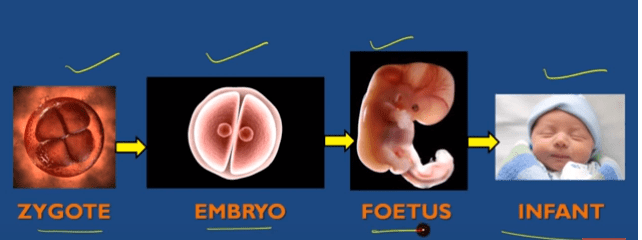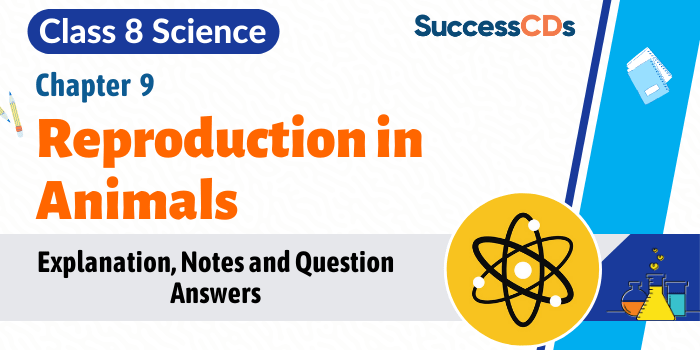
Reproduction Class 8 Science Chapter 9 as per NCERT Book used in CBSE and other Schools. The lesson covers the complete explanation of class 8 Chapter 9 Reproduction. Topics covered are Reproduction, Sexual Reproduction, Asexual Reproduction, Terminology Involved, Male Reproductive system, Female Reproductive system, Fertilization in Humans, Sex Determination and Metamorphosis. The lesson covers all important questions based on reproduction. NCERT solutions to book questions have also been provided for the convenience of the students.
The topics we will cover in this chapter are as follows:
- Reproduction
- Sexual Reproduction
- Asexual Reproduction
- Terminology Involved
- Male Reproductive system
- Female Reproductive system
- Fertilization in Humans
- Sex Determination
- Metamorphosis
Reproduction Class 8 Video Explanation
Reproduction
It is defined as the process of producing young ones. The process of reproduction is not essential for the survival of an individual but reproduction is essential for the continuation of a species. The benefits of reproduction are as follows-
- Reproduction ensures continuity of life on earth.
- Reproduction acts as a bridge to hereditary transmission.
- It involves continuation of characters from the parents to daughter cells by Copying of DNA (Deoxyribose Nucleic Acid) molecules present in the chromosomes of the cell.
- Copying of DNAs is also not a foolproof exercise, even minute changes bring about variation in the blueprint of the offsprings.
- The useful variations are retained while the harmful ones do not go beyond.
- Actually, variations help the species to withstand drastic environmental changes, thus, save the species from becoming extinct and promote their survival for a longer time.
- This inbuilt tendency of variation is the “fuel” for Evolution.
Types of Reproduction
There are two types of Reproduction which are as follows:
- Asexual Reproduction
- Sexual Reproduction
Asexual Reproduction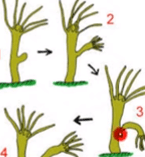
In asexual reproduction, offspring is produced from body parts other than reproductive organs. It is seen in lower plants and animals. For example Hydra.
Asexual reproduction is also defined as the type of reproduction in which only a single parent is involved. In asexual reproduction, sex cells (gametes) are not produced. No fusion of gametes takes place for the production of zygote or offspring. It is only produced from the body parts.
Features of Asexual reproduction
The features of asexual reproduction are as follows –
- It is uniparental.
- The offspring produced by asexual reproduction is clone of parent. This means that it is exactly a carbon copy of the parent.
- It is a fast mode of reproduction.
Different forms of Asexual Reproduction are as follows:
Binary Fission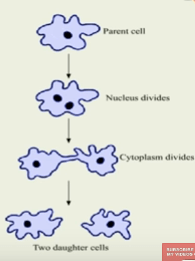
Binary Fission is a type of asexual reproduction in which parent cell splits into 2 daughter cells. Binary means two and fission means splitting. For example: Amoeba.
Amoeba is a single celled organisms that reproduces new individual of its type by dividing its nucleus into two nuclei.
After division of the nucleus, the body of amoeba divides into two parts with each individual part receiving a nucleus.
The two separate bodies of amoeba develop into new individuals.
This method of reproducing new individual by dividing into two individuals is called binary fission.
Steps involved in binary fission are as follows-
- The Amoeba first grows in size.
- Then its nuclear material doubles.
- Constriction appears.
- Followed by division of cytoplasm.
- Finally two daughter cells (offsprings) are formed.
Budding
In Budding, a new organism is produced as an outgrowth of the parent
body part. For example Hydra.
Reproduction in hydra starts by the development of bulges called buds.
The buds are the small outgrowths from a parent hydra that develops into a new hydra.
As the new individual develops from buds the process of reproduction in hydra is called budding.
Spores are small, bulb-like structures that develop at the top of the erect hyphae of the fungus plant. These spores are released into the air and germinate. These spores are also released into new individuals after landing into food or soil.
Fragmentation
It is the accidental process when the broken pieces of an organism (fragments) grows into a complete organism. For example: Fragmentation in spirogyra.
Regeneration
When the simple animals like Hydra, Planaria develop a new individual from their broken older part it is known as regeneration. It is carried out by specialized cells which grow large numbers of cells.
Sexual Reproduction
In sexual reproduction, offspring is produced due to the involvement of two sexes and that is male and female. No two males or females can produce offspring. Only opposite sexes have capacity to produce offspring.
Reproduction takes place as a result of fusion between two gametes, one from each parent, it is called sexual reproduction.
This process of fusion between two gametes is called fertilization.
The formation of gametes involves exchange of chromosomal (genetic)
fragments between homologous chromosomes causing genetic
recombination which leads to variation.
Features of Sexual reproduction are as follows –
It is biparental
The offspring inherits some characters from parents and some new characters. The process of fusion between two gametes is known as fertilization. For example: If Father has blue eye, sometimes offspring also has blue eyes. This is due to the inheritance of characters.
In this process of sexual reproduction, a male and a female gamete (reproductive cells) fuse to form a single cell called Zygote. This zygote gradually develops into an adult, similar to the parents. The individual that grows from a zygote, receives characters of both mother and father.
Q: Explain the importance of reproduction in organisms.
Answer: The importance of reproduction in organisms is:
1. Reproduction is essential for the continuation of a species.
2. Reproduction ensures the continuation of similar kinds of individuals, generation after generation.
Reproduction in Human Beings
Sexes: In this reproduction, both sexes are involved and that are Male and female.
Gonads: The reproductive organs of organisms. Both male and female have gonads.
Male gonad
Testis is the male gonad. They produce gametes. Gametes are the cells that are actually participate in fusion process of fertilization. Male gamete is also called sperm.
Female gonad
Ovaries are known as female gonad. Ovaries produces gametes and gametes are known as ovum or egg.
Fertilization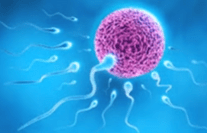
It is a fusion of male and female gametes to produce first cell that is called as ZYGOTE.
Types of Fertilization
- External Fertilization
- Internal Fertilization
External Fertilization
In this males release sperms and females lay eggs. The fusion of egg and sperm takes place outside the parent’s body. This occurs mostly in aquatic organisms. In this fertilization, all organisms gather in a group. Then, male organisms release their sperms and at the same time female organism release their eggs in water. The fusion of egg and sperm takes place in water and thereby, zygote forms in the water. Hence, offspring is also form in the water. In this process, no parent body in involved.
For example: Larvae stages of frog.
In case of the reproduction of frogs, the male and female frogs come together.
Female frogs lay down the eggs. A layer of jelly holds and protects the eggs.
The male frogs deposit the sperms over the eggs laid by the female frog.
The sperm swims in water using its long tail and comes in contact with the eggs.
When the sperms comes in contact with the eggs, they fuse that and lead to the further development of the eggs into a new individual.
This type of fertilisation in which the male and female gametes fuse outside the female body is called external fertilisation.
Internal Fertilization
In this fertilization, male releases sperm in the females body. Fertilization occurs inside the female body. When baby is fully formed, then it is delivered out.
The different stages that occur in internal fertilization are as follows:
Zygote: It is the first cell formed after fusion.
Embryo: Ball of cells arisen from single-celled zygote.
Foetus: In foetus, development of baby occurs after 8 week of fertilization.
Infant: A baby with fully developed organs
Male Reproductive System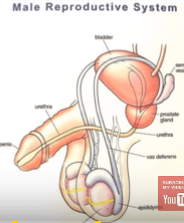
Testes: The function of testis is sperm formation. It is facilitated by male sex hormone testosterone.
Scrotum: Scrotum is sac like structure that provides 2 to 3 degree less temperature than body temperature. This 2-3 degree less temperature is required for sperm formation.
Epididymis: Epididymis is helpful in storing sperms temporarily.
Vas deferns: It is a duct that carries sperms.
Seminal vesicle: This is a gland that secretes a fluid called seminal fluid. Functions of seminal fluid are as follows:
- It provides motility medium to sperms. Motility means ability to move.
- It provides nutrition to sperms.
When sperm and seminal fluid fuse, then it is called as semen.
Common duct: It is a duct formed by urethra and vas deferns for the secretion of urine as well as semen.
Structure of Sperm
The secretion of white liquid from male reproductive organ is known as sperm.
It consists of 3 parts which are as follows:
- Head
- Middle piece
- Tail
Head
It has a nucleus and a hydrolyzing enzyme at tip which is capable of lysis ovum. The tip of sperm is called as acrosome. It is very important during the fusion and thereby helpful in fertilization.
Middle Piece
It has a mitochondria that provide energy to sperm. Mitochondria is also known as power house of cell.
Tail
It helps in movement of sperm. We can also say that this shows lashing movements. Flagellum is concerned with movement and is present in tail.
Question: Sperm duct finally opens into the ______.
- ureter
- urethra
- testes
- testis
Answer: Urethra
Question: Sperms are nourished and activated ______
- through vas deferens
- through seminal vesicle
- through semen
- through prostate gland
Answer: 3. through semen
Question: Zygote with three copies chromosome 21, is known to cause __________
- Hays fever
- Scurvy
- Parkinson Disease
- Downs syndrome
Answer: 4. Down syndrome
Question: Types of gametes produced by 2 pair of chromosomes can be
- 4
- 6
- 8
- 10
Answer: 1. (4)
Question: Organs producing reproductive cells are called as ______.
- gametes
- gonads
- globules
- glands
Answer: 2. Gonads
Question: Why do sperms need to have mobility?
Answer: Sperms have to enter the female reproductive passage. Sperm fertilize the ovum by travelling through the vagina & uterus for this in the fallopian tube/ oviduct.
Female Reproductive system
Ovaries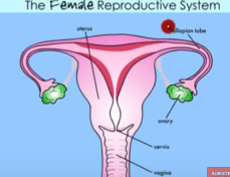
Its function is egg formation. Oestrogen is the hormone which is helpful in the formation of egg.
Fallopian tube
It is also called as oviduct. Its function is to receive matured egg. Fertilization also takes place in fallopian tube.
Uterus
A sac where baby develops. It is also known as mother’s womb. It is the place where baby stays for 9 months during pregnancy.
Cervix
It is a cap of vagina.
Vagina
Vagina is the part that receives sperms.
Egg formation occurs in both ovaries since puberty, but only one egg mature each month and that is from alternate ovaries. The egg maturation take few days and once the egg is formed it is released in fallopian tube. This release is called as ovulation.
Ovulation
It is the process of release of an egg from the ovary into the fallopian tube.
Q: In which female reproductive organ does the embryo get embedded?
Answer: The female reproductive organ in which the embryo gets embedded is in the walls of the uterus.
Fate of Ovum
It includes two processes which are as follows:
- To get fertilized
- Mensuration
To get fertilized, there is a sequence of events that takes place.
Gamete formation
Formation of egg and sperm occurs in female and male bodies, respectively.
Ovulation
Once the egg is formed it is released from ovary into fallopian tube.
Copulation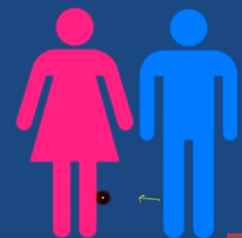
It is an act in which mating of male with female occurs. It this process males sperms enter into females body.
Fertilization
The fusion of sperm and egg to from zygote is fertilization. There are multiple sperms in one secretion, some of them get destroyed and only one sperm is able to fuse with the egg. This process of fertilization occurs in fallopian tube.
Implantation
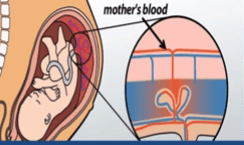
It is defined as fixing of Zygote into the uterine wall.
Placenta Formation
It is a temporary formed tissue that provides nutrition to growing embryo. This cord is cut down when the baby is delivered.
Gestation period
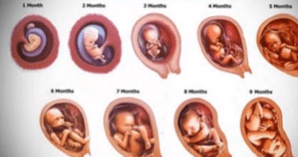
The period of development of zygote into fully grown offspring which is ready for delivery. It is 9 months 9 days process.
Parturation
It is the process of expelling fully grown baby from mother’s womb.
Time to check your knowledge by answering the following questions-
Q1. Why is reproduction important?
Answer: It is because of reproduction that life continues from one generation to another.
Q2. What is menstruation?
Answer: If the ovum is not fertilized by a sperm, it is expelled from the uterus along with some uterine muscles and blood. This is known as menstruation.
Q3. How does Hydra reproduce?
Answer: Hydra reproduces by budding. In Hydra, a bud appears on the body wall which grows into a full Hydra in a day or two and separates from the parent.
Q4. How does placenta help the foetus?
Answer: The placenta is responsible for providing oxygen and nutrients and removing waste substances from the uterus.
Q5. What is metamorphosis?
Answer: The series of changes in an organism during its life cycle that transform it from the larva to an adult are called metamorphosis.
Q6. How is zygote formed in humans? Where is it formed?
Answer: The fusion between a male gamete and a female gamete in the oviduct results in the formation of a fertilized egg or zygote in humans. It is formed in the fallopian tube of females.
Q7. Which two processes are responsible for the development of embryo in multicellular organisms?
Answer: In multicellular organisms, development of embryo occurs by cell division and cell differentiation.
Q8. Explain what happens after a hen lays a fertilized egg?
Answer: Once the hen lays a fertilized egg, it sits on the egg to keep it warm. Development of the chick takes place inside the shell. After its development is complete, the chick comes out by bursting open the egg shell.
Q9. What is incubation?
Answer: The process of keeping the eggs warm in order to hatch is called incubation.
Sex Determination
It is the process by which sex of a child is determined.
- There is 50-50 percent chance of boy or girl.
- Sex of child is determined by father as father produces different types of gametes.
Male has XY chromosomes and females has XX chromosomes. When X chromosome of male fuses with X chromosome of female, it forms a female child. Alternatively, if Y chromosome of male fuses with X chromosome of female, it forms a male child.
Different types of animals
On the basis of how they produce offspring, there are two different types of animals as follows-
- Viviparous
- Oviparous
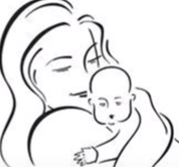
Viviparous
They are those organisms that give birth to young ones. In this process, fertilization occurs inside the body. For example: Mammals, Cow, Horse, Dog etc.
Oviparous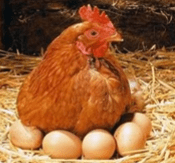
These are those organisms that lay eggs and when they get the required temperature then eggs hatch into offsprings. For example: Birds, Snakes, Frogs etc.
Metamorphosis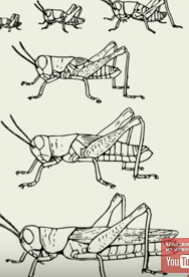
It is a series of changes that larvae undergo to form an adult.
Let us consider an example of the transformation of a tadpole into a frog.
As a tadpole develops into a frog, it looks very different from the late tadpole and has different properties from tadpole.
But in case of human beings, the body parts and features of an adult are same as in their young ones.
IVF or In-vitro fertilization
Q: What are test tube babies and how are they produced?
Answer: A biological fertilization carried out in laboratory is called in-vitro. Thus, fertilization carried out in laboratory is called in-vitro fertilization.
Some women are unable to bear babies because their oviducts are blocked. As a result, sperms cannot reach the egg for fertilization. Doctors collect freshly released eggs and sperms and keep them together for a few hours for IVF or in – vitro fertilization (fertilization outside the body).
If fertilization occurs, the zygote is allowed to develop for about a week and then it is transferred in the mother’s uterus. Whole development takes place in the uterus and the baby is born like any normal baby. Babies born through this technique are called test-tube babies.
Q: What is fertilization? Give its two types.
Answer: Fertilization is the fusion of a male gamete with a female gamete to form a zygote. There are two types of fertilization which are as follows:
External and internal fertilization.
Q: Write full form of IVF.
Answer: The full form of IVF is In – Vitro Fertilization.
Q: What are sexually transmitted diseases? Give examples.
Answer: They are those diseases that spread through one person to another person through sexual contact. For example: ADIS, Syphilis, Gonorrhea etc.
Q: Explain life cycle of silkworm.
Answer: Egg ➔Larvae➔Pupa➔Adult
NCERT Book Solutions
Multiple-choice questions
1. The animals that produce new young ones are known as?
I. Oviparous
II. Viviparous
III. Both
IV. None of these
2. Tadpole is the developing stage of which of these?
I. Dogs
II. Cats
III. Frogs
IV. Humans
3. Where does the fusion of male and female gametes generally take place?
I. Fallopian tube
II. Ovary
III. Uterus
IV. Zygote
4. The cell formed after fertilization is called as?
I. Foetus
II. Zygote
III. Embryo
IV. None of these
5. Egg are formed in ?
I. Testes
II. Penis
III. Ovary
IV. None of these
6. How many modes of reproduction are there in animals?
I. One type
II. Two types
III. Three types
IV. Four types
7. A sperm consists of ?
I. One part
II. Two parts
III. Three parts
IV. Four parts
8. Foetus is defined as?
I. Well developed embryo
II. Developing embryo
III. A zygote
IV. Male gamete
9. Viviparous organisms are the ones which
I. Produce eggs
II. Produce young ones
III. Both I and II
IV. None of these
10. Cloning is a mode of
I. Sexual reproduction
II. Asexual reproduction
III. Both I and II
IV. None of these
ANSWERS
- II
- III
- I
- II
- III
- II
- III
- I
- II
- II
Q: Describe fertilization in hens.
Answer: Hens exhibit internal fertilization. The zygote is formed following fertilization, divides repeatedly, and rolls down the oviduct. It gets surrounded by many protective sheath or layers including the hard outermost shell. After the hard shell is formed around the embryo, the hen lays egg. The hen then sits on the egg to keep it warm. Development of the chick takes place inside the shell. It takes about 3 weeks for the embryo to develop in to a chick. After its development is complete, the chick comes out by bursting open the egg shell.
Q: Choose the most appropriate answer:
1. Internal fertilization occurs
(i) in female body. (ii) outside female body.
(iii) in male body. (iv) outside male body.
2. A tadpole develops into an adult frog by the process of
(i) fertilization. (ii) metamorphosis.
(iii) embedding. (iv) budding.
3. The number of nuclei present in a zygote is
(i) none. (ii) one.
(iii) two. (iv) four.
Answers:
- (i) in female body.
- (ii) metamorphosis.
- (ii) one.
Indicate whether the following statements are True (T) or False (F):
- Oviparous animals give birth to young ones.
- Each sperm is a single cell.
- External fertilization takes place in frog.
- A new human individual develops from a cell called gamete.
- Egg laid after fertilization is made up of a single cell.
- Amoeba reproduces by budding.
- Fertilization is necessary even in asexual reproduction.
- Binary fission is a method of asexual reproduction.
- A zygote is formed as a result of fertilization.
- An embryo is made up of a single cell.
Answers:
- Oviparous animals give birth to young ones. (False)
- Each sperm is a single cell. (True)
- External fertilization takes place in frog. (True)
- A new human individual develops from a cell called gamete. (False)
- Egg laid after fertilization is made up of a single cell. (True)
- Amoeba reproduces by budding. (False)
- Fertilization is necessary even in asexual reproduction. (False)
- Binary fission is a method of asexual reproduction. (True)
- A zygote is formed as a result of fertilization. (True)
- An embryo is made up of a single cell. (False)
